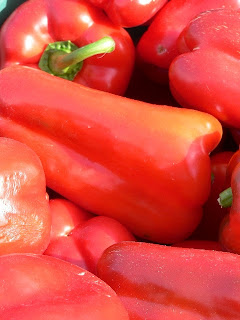I don't want my family eating food that includes things made from petroleum or coal tar.
| Photo by resilientearth.com |
Every time we travel, I realize just how differently the rest of the world shops, cooks and eats.
Synthetic food dyes are derived primarily from petroleum and coal sources- they provide no nutritional or quality value to food.
| Photo by Piccolo Namek |
| Photo by tlindenbaum |
In the U.S., Kellog's strawberry Nutri-Grain Bar is colored with red 40, yellow 6 and blue 1; in Britian, the same product contains beetroot red, annatto and paprika extract.
How do you stop using synthetic colors, flavors and preservatives?
1. Read the label on everything you buy.
Don't worry. You'll get fast at it. Artificial colors, dyes and preservatives are masked by many names. Look up any ingredients you don't recognize, you'll memorize them like an old elementary school vocabulary list!
2. Get it out of your house. All of it. Don't let it back in.
Sort through your entire refrigerator and pantry throwing away everything that has a synthetic ingredient.
3. Obstain.
Don't buy it. Don't eat at restaurants that use them (Yes, you'll need to ask.). Don't let your kids eat the school lunch unless they have access to a rare organic program.
4. Educate your kids.
Research the ingredients together. They are as likely not to want to eat coal tar as you are; read about the studies that show rats are hyper, confused and more prone to cancer on these ingredients, read about how the additives are made and where they come from.
5. Change the way you eat and shop.
Cook homemade foods. Freeze if time doesn't allow for nightly cooking. Learn simple, fast, homemade recipes. Shop more frequently (foods won't last as long- Europeans have very small refrigerators!). Buy the freshest foods you can buy. Become a regular at the local farmer's markets and consider a CSA where a local grower delivers a box of produce to you.
6. Be patient and ask for help.
This is a gargantuan change and can seem overwhelming. You are not alone. Visit natural food markets and ask for recipe ideas and produce help, you'll find a whole new community to help you along the way.
7. Be aware.
Watch for wellness changes . . . in skin, in behavior, in learning, in your family dynamic. Are relationships and healthiness improving? Keep it up!
8. Advocate.
J's body used to look like this:
Since he stopped eating artificial colors, flavors and preservatives his skin has normalized. He's like a canary in a coal mine however, whenever he deviates out emerges painful streaks of eczema. Slowly, he's embracing owning this and deciding to abstain from the foods that he knows will cause his skin to erupt. It feels like a punishment to have to monitor our food to this extent, someday I imagine we might be grateful because it forces to be healthy.

No comments:
Post a Comment